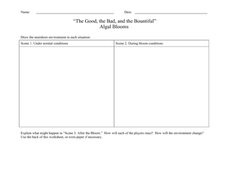Curated OER
Bad Algae!
Students explore algal blooms. In this ecosystem and health lesson, students define and describe harmful algal blooms, then discuss ways in which the impact of these algal blooms could be reduced. Students work in groups to research...
Curated OER
"The Good, the Bad and the Bountiful"-Algal Blooms
In this algal blooms worksheet, students draw the near-shore environment prior to an algal bloom and then during an algal bloom. Students predict what the environment would look like after the algal bloom.
Curated OER
"The Good, The Bad, and the Bountiful" Algal Blooms
In this biology worksheet, students draw 2 illustrations of the nearshore environment before and during algal blooms. They explain what happens after the bloom is over.
Science Education Resource Center at Carleton College
Serc: Investigating the Ocean Algal Blooms
This NOAA computer-based activity is designed to teach students in grades 9-12 how satellite imagery and remote sensing can be used to monitor harmful algal blooms (HABs). This lesson teaches students how to read and interpret satellite...
National Geographic
National Geographic: Human Impacts on Marine Species
Students learn about three examples of human impacts on marine life: migration patterns and shipping, algal blooms and water chemistry, and marine debris. Some of these impacts are due to human activity in the ocean, and some impacts on...
NOAA
Noaa: Estuaries 101 Curriculum: Dissolved Oxygen in an Estuary
In this activity, students focus on the relationship between dissolved oxygen, plant growth, chlorophyll-a and temperature using SWMP water quality data from monitoring stations in the Narragansett Bay Estuarine Research Reserve and the...
NOAA
Noaa: Estuaries 101 Curriculum: Nutrients in an Estuary
An overload of nutrients, called eutrophication (Greek for "good-nutrition"), can be harmful to estuaries. This phenomenon is also referred to as "over-enrichment," or "nutrient pollution". Students will investigate the range of...
Other
Nasa: From the Top of the World to the Bottom of the Food Web
Teachers and students discover linkages among marine ecology, phytoplankton, the behavior of light at the ocean surface, and satellite-derived ocean color data. Explore the topics of phytoplankton, food webs, and algal blooms using...









